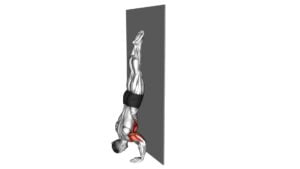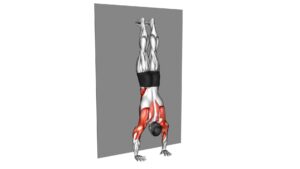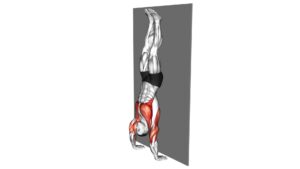Handstand Against the Wall – Video Exercise Guide & Tips

Are you looking to improve your handstand skills? Look no further!
Watch This Exercise Video
This video exercise guide and tips for handstand against the wall will help you achieve your goals. With proper alignment and warm-up exercises, you'll be on your way to mastering this challenging pose.
Our step-by-step instructions and common mistake avoidance will ensure you're practicing safely and effectively.
Plus, we'll share tips for progressing and holding your handstand longer.
Get ready to flip your world upside down!
Key Takeaways
- Handstand against the wall offers benefits such as increased strength, improved balance, enhanced body awareness, and building upper body and core strength.
- Proper alignment and placement for handstand include hands shoulder-width apart, fingers spread wide for stability, straight arms and stacked shoulders, and a straight line from wrists to heels.
- Warm-up exercises for handstand, such as shoulder circles, cat-cow stretch, wrist stretches, and downward-facing dog, are important to increase blood flow, flexibility, and reduce the risk of injury.
- Common mistakes to avoid in handstand include arching the back or collapsing the shoulders, incorrect hand placement, underestimating the importance of core strength, and maintaining proper alignment and focus on a fixed gaze.
Benefits of Handstand Against the Wall
Experience the numerous benefits of practicing handstand against the wall, including increased strength, improved balance, and enhanced body awareness.
Handstand progressions and variations against the wall are excellent exercises for building upper body and core strength. By regularly practicing handstands, you can strengthen your shoulders, arms, and wrists, which can improve your overall upper body strength and stability. Additionally, this exercise challenges your core muscles, helping to develop a strong and stable core.
Handstand against the wall also improves balance and body awareness. As you work on maintaining your balance in the handstand position, your body develops a greater sense of proprioception, which is the ability to sense the position and movement of your body. This increased body awareness can translate into improved balance not only in handstands but also in other activities and sports.
By incorporating different handstand variations, such as tuck handstands or straddle handstands, you can target different muscle groups and further enhance your strength and balance. These variations also add variety to your practice, making it more engaging and exciting.
Now that you understand the benefits of practicing handstand against the wall, let's explore the importance of proper alignment for a safe and effective handstand.
Proper Alignment for Handstand
Achieving proper alignment is crucial for a safe and effective handstand. When practicing handstand against the wall, it's important to maintain proper alignment to prevent injuries and maximize the benefits of the exercise.
To achieve proper alignment, start by placing your hands shoulder-width apart on the ground, with your fingers spread wide for stability. Engage your core and press through your palms to lift your hips up towards the ceiling. Keep your arms straight and your shoulders stacked directly above your wrists. Your body should form a straight line from your wrists to your shoulders, hips, and heels. Avoid arching or rounding your back, as this can lead to strain or discomfort.
As you gain strength and stability, you can progress to handstand variations such as scissor handstands or one-handed handstands. Remember to always prioritize proper alignment and listen to your body as you explore different handstand progressions.
Warm-Up Exercises for Handstand
Before you begin practicing handstand against the wall, it's important to warm up with specific exercises to prepare your body for the movement. Warming up helps increase blood flow, improve flexibility, and reduce the risk of injury. Here are four warm-up exercises that will help you get ready for your handstand practice:
- Shoulder circles: Stand with your feet shoulder-width apart and gently circle your shoulders forwards and backwards. This exercise helps to increase shoulder mobility, which is crucial for maintaining balance in a handstand.
- Cat-Cow stretch: Begin on all fours, with your hands directly under your shoulders and your knees under your hips. As you inhale, arch your back and lift your head towards the ceiling, creating a hollow position. As you exhale, round your back and tuck your chin towards your chest. This stretch helps to warm up your spine and increase core stability.
- Wrist stretches: Place your hands on the ground, fingers pointing towards your feet, and gently lean forward to stretch your wrists. You can also rotate your wrists in circles to improve mobility and flexibility.
- Downward-facing dog: Start in a plank position and push your hips up towards the ceiling, creating an inverted V shape with your body. This pose stretches your hamstrings, calves, and shoulders, while also improving overall body awareness and alignment.
Step-by-Step Guide to Handstand Against the Wall
To begin practicing handstand against the wall, position yourself facing the wall with your hands about shoulder-width apart. Start in a standing position with your feet hip-width apart. Bend forward at the waist and place your hands on the floor, shoulder-width apart. Walk your feet up the wall until your body is in an inverted V shape, with your hips directly over your shoulders. Slowly walk your feet up the wall until your body is fully extended and you're in a handstand position with your back against the wall.
To progress in your handstand practice, you can try different handstand variations. One variation is the straddle handstand, where you open your legs into a wide V shape while upside down. Another variation is the tuck handstand, where you bring your knees towards your chest while in the handstand position. These variations help to challenge your balance and strengthen different muscle groups.
Now that you know how to position yourself for a handstand against the wall and how to progress with different variations, let's move on to the next section and discuss common mistakes to avoid in handstand.
Common Mistakes to Avoid in Handstand
When attempting a handstand against the wall, it's important to be mindful of your balance and alignment. Avoid arching your back or collapsing your shoulders, as this can lead to instability.
Additionally, ensure that your hands are placed correctly, with your fingers spread wide and your weight evenly distributed.
Lastly, don't underestimate the importance of core strength in maintaining a stable and controlled handstand position.
Balance and Alignment
How can you maintain balance and alignment in your handstand to avoid common mistakes? Here are four tips to help you improve stability and execute handstand variations correctly:
- Engage your core: A strong core is crucial for maintaining balance in a handstand. Activate your abdominal muscles and keep them engaged throughout the exercise.
- Align your body: Proper alignment is key to a successful handstand. Keep your wrists stacked under your shoulders and your hips over your shoulders. Avoid arching or rounding your back to maintain a straight line from your fingertips to your toes.
- Focus on your gaze: Fix your gaze on a point on the floor to help stabilize your body. Keep your head in line with your spine, avoiding the temptation to look up or down.
- Practice against a wall: Using a wall can provide support and help you find your balance. Start by facing the wall and gradually work on reducing your reliance on it.
Proper Hand Placement
Maintain proper hand placement to avoid common mistakes and ensure stability in your handstand. Correct hand placement is crucial for maintaining balance and preventing injuries.
To achieve the correct hand placement in a handstand, start by positioning your hands shoulder-width apart on the ground. Your fingers should be spread wide and pointing forward. This helps to distribute your weight evenly and provides a solid foundation for your handstand.
As you progress in your handstand practice, you can experiment with different hand placement techniques, such as fingers pointing slightly outwards or inwards, to find what feels most comfortable and stable for you. Remember to keep your wrists aligned with your shoulders to avoid straining them.
With consistent practice and proper hand placement, you can improve your handstand progressions and build strength and stability in your upper body.
Core Strength Importance
To continue building stability and avoiding common mistakes in your handstand, it's important to understand the importance of core strength. Your core stability plays a crucial role in maintaining balance and control while upside down.
Here are four core exercises for handstand that can help improve your stability:
- Plank: Start in a push-up position, engaging your core muscles and keeping your body in a straight line from head to toe. Hold for 30 seconds to 1 minute.
- Hollow Body Hold: Lie on your back with your arms and legs extended. Lift your shoulders and legs off the ground, engaging your core. Hold for 30 seconds to 1 minute.
- Russian Twists: Sit on the ground with your knees bent and feet lifted. Rotate your torso side to side, touching the ground with your hands. Aim for 10-15 reps on each side.
- Superman: Lie on your stomach with your arms and legs extended. Lift your arms, chest, and legs off the ground, squeezing your glutes. Hold for 30 seconds to 1 minute.
Tips for Progressing and Holding Handstand Longer
To improve your handstand endurance, practice regularly and incorporate strengthening exercises to build core and upper body strength. Improving your balance is key to holding a handstand for a longer duration. Here are some tips to help you progress and hold your handstand longer.
First, start by practicing against a wall. This will provide support and help you build confidence while you work on your balance. As you become more comfortable, try gradually reducing the amount of support from the wall.
Next, incorporate handstand variations into your practice. Experiment with different hand placements, such as wide or narrow, to challenge your balance and engage different muscle groups. You can also try practicing on different surfaces, like grass or sand, to further challenge your stability.
Additionally, focus on your breath and alignment. Take deep breaths to help calm your mind and maintain focus. Keep your body aligned by engaging your core, squeezing your glutes, and pointing your toes.
Finally, be patient and consistent. Progressing in handstands takes time and practice. Set realistic goals and celebrate small achievements along the way. Remember to listen to your body and take breaks when needed.
Frequently Asked Questions
How Long Should I Hold a Handstand Against the Wall?
To progress in a handstand against the wall, it's important to start with short holds and gradually increase the time. As for how long you should hold it, aim for 10-30 seconds initially. This will help build strength and stability.
Common mistakes to avoid include arching your back, not engaging your core, and relying too much on the wall for support.
With practice, you can gradually increase the duration of your handstand holds.
What Are Some Modifications or Variations for the Handstand Against the Wall?
When it comes to handstand variations and modifications, there are several options you can try. These can include using props like a yoga block or a stability ball to assist you in finding balance and stability.
You can also experiment with different hand placements, such as wide or narrow, to target different muscle groups.
Additionally, you can explore one-legged handstands or tuck handstands to challenge yourself further.
Remember to always prioritize safety and listen to your body when trying new variations.
Can Handstand Against the Wall Help Improve Balance and Core Strength?
Handstand against the wall is a great exercise to improve balance and core strength. By practicing this exercise, you can enhance your stability and strengthen your abdominal muscles.
Additionally, it can help improve flexibility in your shoulders and wrists. The benefits of handstand against the wall include increased body awareness and improved posture.
Incorporating this exercise into your routine can provide a challenging and effective way to enhance your overall fitness level.
Are There Any Specific Breathing Techniques to Use During a Handstand Against the Wall?
During a handstand against the wall, it's important to focus on your breathing techniques to maintain control and stability. By taking slow, deep breaths, you can help relax your body and mind, allowing you to find balance in the pose.
Proper handstand alignment is also crucial for a successful handstand against the wall. Make sure to keep your arms straight, shoulders engaged, and core tight. This will help you stay strong and steady throughout the exercise.
Can Practicing Handstand Against the Wall Help With Other Advanced Yoga Poses or Inversions?
Practicing handstand against the wall can definitely help with other advanced yoga poses and inversions. By building strength in your shoulders, core, and arms, you'll be better equipped to tackle more challenging poses.
Additionally, handstand progressions can improve your balance, body awareness, and overall confidence in inversions.
Conclusion
In conclusion, practicing handstands against the wall offers numerous benefits such as strengthening the upper body, improving balance, and boosting confidence.
By following proper alignment and incorporating warm-up exercises, you can enhance your handstand practice and avoid common mistakes.
Remember to progress gradually and focus on maintaining proper form to hold the handstand longer.
With dedication and consistency, you can master this challenging yet rewarding exercise.

Author
Years ago, the spark of my life’s passion ignited in my mind the moment I stepped into the local gym for the first time. The inaugural bead of perspiration, the initial endeavor, the very first surge of endorphins, and a sense of pride that washed over me post-workout marked the beginning of my deep-seated interest in strength sports, fitness, and sports nutrition. This very curiosity blossomed rapidly into a profound fascination, propelling me to earn a Master’s degree in Physical Education from the Academy of Physical Education in Krakow, followed by a Sports Manager diploma from the Jagiellonian University. My journey of growth led me to gain more specialized qualifications, such as being a certified personal trainer with a focus on sports dietetics, a lifeguard, and an instructor for wellness and corrective gymnastics. Theoretical knowledge paired seamlessly with practical experience, reinforcing my belief that the transformation of individuals under my guidance was also a reflection of my personal growth. This belief holds true even today. Each day, I strive to push the boundaries and explore new realms. These realms gently elevate me to greater heights. The unique combination of passion for my field and the continuous quest for growth fuels my drive to break new ground.







